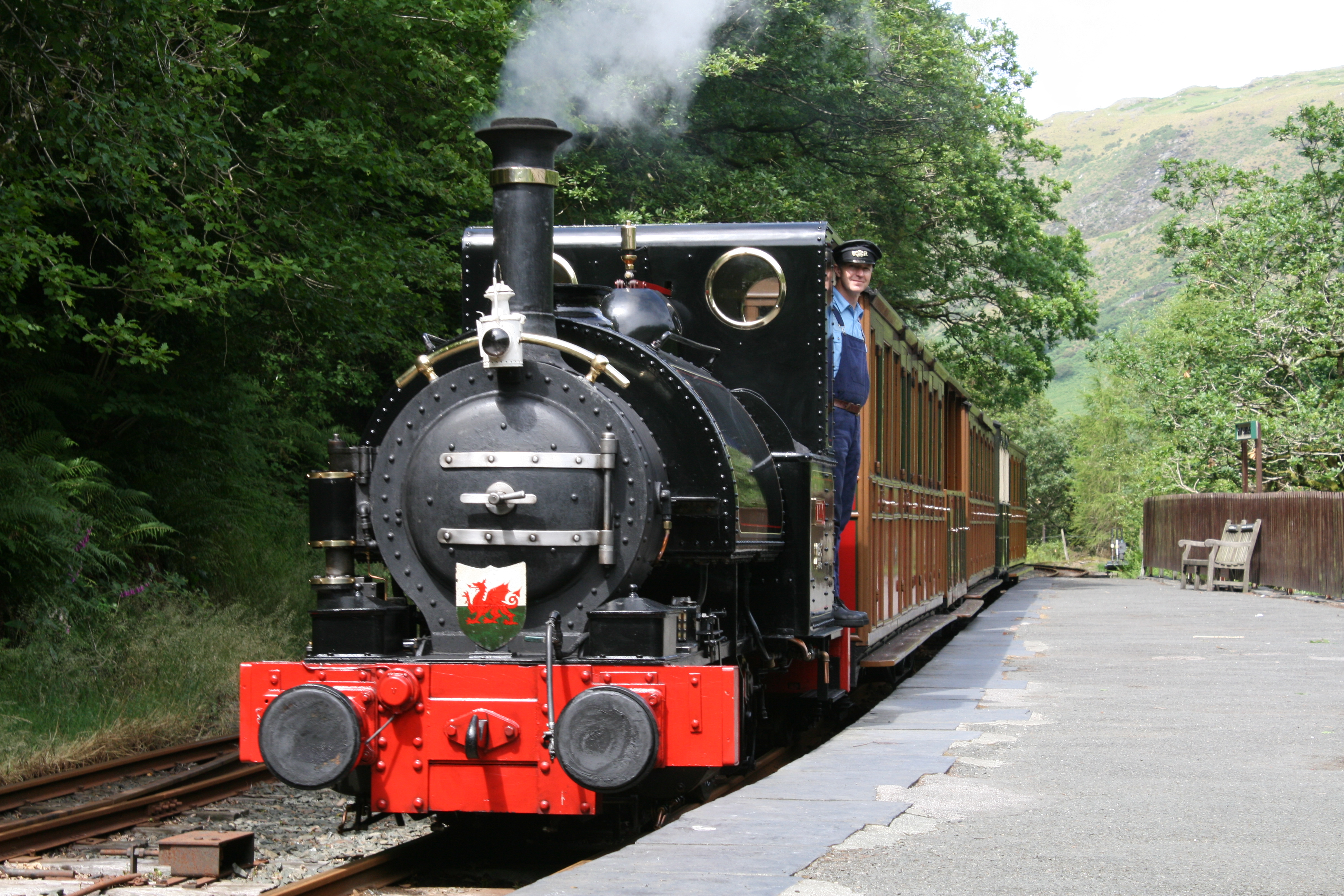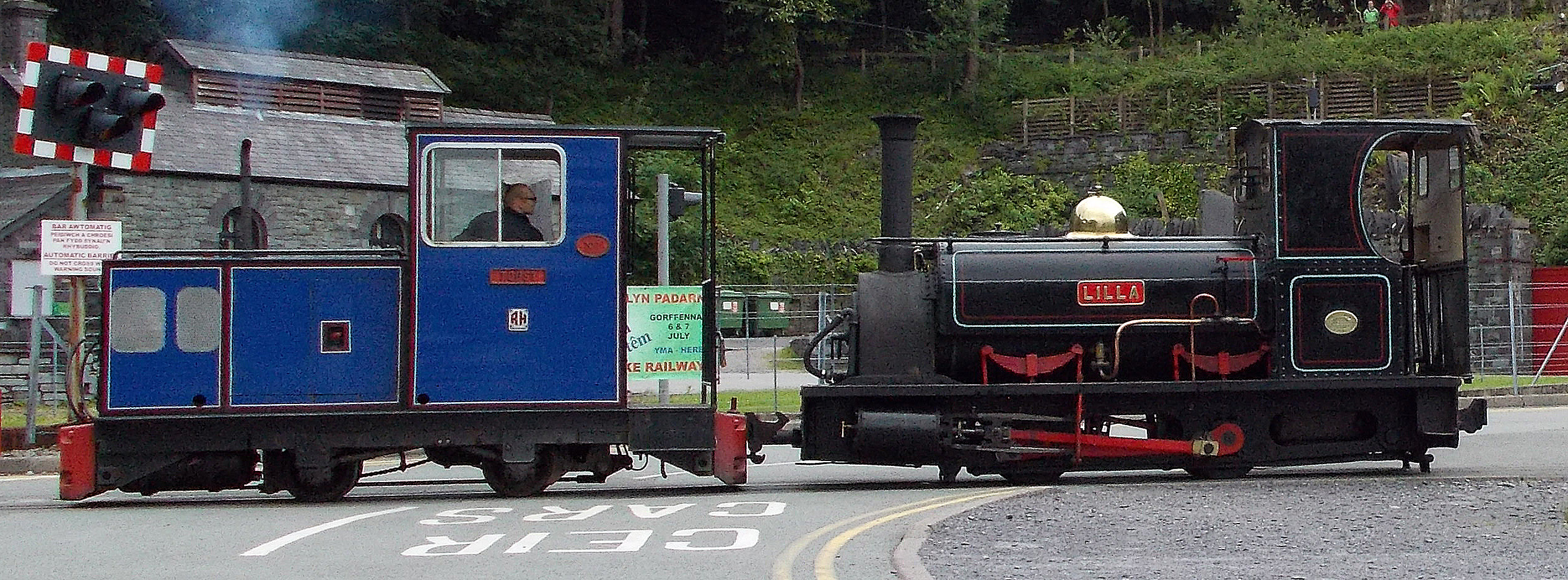|
Bryngwyn Railway Station
Bryngwyn railway station is a former station which was the terminus for passengers on the Bryngwyn Branch of the North Wales Narrow Gauge Railways, and later the Welsh Highland Railway. Beyond the station, an incline climbed the slope of Moel Tryfan to serve a series of slate quarries. Those connected by tramways to the incline head included the Alexandra quarry, Moel Tryfan quarry, Fron quarry, Braich quarry and Cilgwyn quarry. History At Bryngwyn a 1 in 10 balanced incline owned by the Welsh Highland Railway led to an upper plateau from where quarry owned lines radiated to several slate quarries in the Moel Tryfan and Nantlle area. Although slate traffic continued as required until final closure in 1936, passenger trains ceased to operate on the branch in 1914. There is very little left of the original Bryngwyn station today, which would have stood in the middle of fields near a farm where the station takes its name. The station consisted of a typical North Wales Narrow Gau ... [...More Info...] [...Related Items...] OR: [Wikipedia] [Google] [Baidu] |
Bryngwyn Halt Railway Station
Bryngwyn Halt railway station is a disused station that was on the Llanfyllin Branch of the Cambrian Railways. It served the villages of Bwlch-y-cibau and Brynderwen between 1863 and 1965. History The Llanfyllin Branch of the Cambrian Railways opened on 17 July 1863. The station was originally named ''Brongwyn''; it was later renamed ''Bryngwyn''. It was from Llanymynech, and took its name from Bryngwyn Hall. In 1866, there was one train on Tuesdays and one on Wednesdays. Originally provided with a wooden shelter, this was later replaced by one of corrugated iron. The platform was situated on an embankment on the west side of the Llanfechain road over bridge with step access to the road. In 1923, the Great Western Railway renamed the station ''Bryngwyn Halt''. It was closed by British Railways British Railways (BR), which from 1965 traded as British Rail, was a state-owned company that operated most of the overground rail transport in Great Britain from 1948 to 199 ... [...More Info...] [...Related Items...] OR: [Wikipedia] [Google] [Baidu] |
Narrow Gauge Railway Museum
The Narrow Gauge Railway Museum (Welsh: ''Amgueddfa Rheilffyrdd Bach Cul'') is a purpose-built museum dedicated to narrow-gauge railways situated at the station of the Talyllyn Railway in Tywyn, Gwynedd, Wales. The museum has a collection of more than 1,000 items from over eighty narrow-gauge railways in Wales, England, the Isle of Man, Ireland and Scotland. This includes six locomotives on display (and several others in store or at other sites); eleven wagons inside with a further eleven outside; a display showing the development of track work from early plateways to modern narrow-gauge tracks; several large signals along with single line working apparatus and documents; a growing collection of tickets and other documents, posters, notices, crockery and souvenirs; relics from vehicles scrapped long ago and the Awdry Study, re-created with the original furniture and fittings in memory of the Rev. Wilbert Awdry, an early volunteer on the Talyllyn Railway best known for his series ... [...More Info...] [...Related Items...] OR: [Wikipedia] [Google] [Baidu] |
Llandwrog
Llandwrog (; Welsh language: meaning 'The church of Saint Twrog') is a village and community in Gwynedd, north-west Wales, most notable for the presence of the headquarters of Welsh record label Sain and the site of Caernarfon Airport. It has a population of 2,466, increasing to 2,539 at the 2011 Census. The community includes the villages of Groeslon, Carmel, Gwynedd, Y Fron, Dinas Dinlle, and Cilgwyn. As suggested by the village name, the parish church is dedicated St Twrog. ChurchinWales.org. Accessdate 18 November 2022. It was the base of the first ever Sea and Mountain Rescue team, and includes the estate of . |
Railway Stations In Great Britain Closed In 1914
Rail transport (also known as train transport) is a means of transport that transfers passengers and goods on wheeled vehicles running on rails, which are incorporated in tracks. In contrast to road transport, where the vehicles run on a prepared flat surface, rail vehicles (rolling stock) are directionally guided by the tracks on which they run. Tracks usually consist of steel rails, installed on sleepers (ties) set in ballast, on which the rolling stock, usually fitted with metal wheels, moves. Other variations are also possible, such as "slab track", in which the rails are fastened to a concrete foundation resting on a prepared subsurface. Rolling stock in a rail transport system generally encounters lower frictional resistance than rubber-tyred road vehicles, so passenger and freight cars (carriages and wagons) can be coupled into longer trains. The operation is carried out by a railway company, providing transport between train stations or freight customer faciliti ... [...More Info...] [...Related Items...] OR: [Wikipedia] [Google] [Baidu] |
Railway Stations In Great Britain Opened In 1877
Rail transport (also known as train transport) is a means of transport that transfers passengers and goods on wheeled vehicles running on rails, which are incorporated in tracks. In contrast to road transport, where the vehicles run on a prepared flat surface, rail vehicles (rolling stock) are directionally guided by the tracks on which they run. Tracks usually consist of steel rails, installed on sleepers (ties) set in ballast, on which the rolling stock, usually fitted with metal wheels, moves. Other variations are also possible, such as "slab track", in which the rails are fastened to a concrete foundation resting on a prepared subsurface. Rolling stock in a rail transport system generally encounters lower frictional resistance than rubber-tyred road vehicles, so passenger and freight cars (carriages and wagons) can be coupled into longer trains. The operation is carried out by a railway company, providing transport between train stations or freight customer faciliti ... [...More Info...] [...Related Items...] OR: [Wikipedia] [Google] [Baidu] |
Rhostryfan Railway Station
Rhostryfan railway station was the intermediate station on the Bryngwyn Branch of the North Wales Narrow Gauge Railways (NWNGR) and its successor the Welsh Highland Railway (WHR). At some time since closure, the station itself has been demolished. Although the line from Tryfan Junction to Bryngwyn has been purchased by the Festiniog Railway Company, there are no immediate plans to reopen the line. In 2011 the trackbed of the line became a public footpath, although with the condition that this would not impede any reopening of the branch line in the future. See also * North Wales Narrow Gauge Railways The North Wales Narrow Gauge Railways (NWNGR) was a railway company that planned to build a number of inter-connected narrow-gauge railways across North Wales. The first two of these lines - jointly known as the "Moel Tryfan Undertaking" - were ... References External links Welsh Highland History, The Bryngwyn Branch {{WHR Disused railway stations in Gwynedd ... [...More Info...] [...Related Items...] OR: [Wikipedia] [Google] [Baidu] |
Tywyn
Tywyn (Welsh: ; in English often ), formerly spelled Towyn, is a town, community, and seaside resort on the Cardigan Bay coast of southern Gwynedd, Wales. It was previously in the historic county of Merionethshire. It is famous as the location of the Cadfan Stone, a stone cross with the earliest known example of written Welsh, and the home of the Talyllyn Railway. Toponymy The name derives from the Welsh ''tywyn'' ("beach, seashore, sand-dune"): extensive sand dunes lie to the north and south of the town. In Middle Welsh, the spelling was generally ''Tywyn''. In the Early Modern period, however, the spelling ''Towyn'' became common in Welsh in order to reflect a slight change in pronunciation at that time. That also came to be the usual spelling in English up to the latter part of the twentieth century. The modern spelling ''Tywyn'' better reflects the current pronunciation in modern Welsh as spoken in north Wales. With the standardisation of the orthography of the Welsh ... [...More Info...] [...Related Items...] OR: [Wikipedia] [Google] [Baidu] |
Talyllyn Railway
The Talyllyn Railway ( cy, Rheilffordd Talyllyn) is a narrow gauge preserved railway in Wales running for from Tywyn on the Mid-Wales coast to Nant Gwernol near the village of Abergynolwyn. The line was opened in 1865Drummond 2015, page 17 to carry slate from the quarries at Bryn Eglwys to Tywyn, and was the first narrow gauge railway in Britain authorised by Act of Parliament to carry passengers using steam haulage. Despite severe under-investment, the line remained open, and in 1951 it became the first railway in the world to be preserved as a heritage railway by volunteers. Since preservation, the railway has operated as a tourist attraction, expanding its rolling stock through acquisition and an engineering programme to build new locomotives and carriages. In 1976, an extension was opened along the former mineral line from Abergynolwyn to the new station at Nant Gwernol. In 2005 a major rebuilding and extension of Tywyn Wharf station took place, including a much-expande ... [...More Info...] [...Related Items...] OR: [Wikipedia] [Google] [Baidu] |
Cable Railway
Cable may refer to: Mechanical * Nautical cable, an assembly of three or more ropes woven against the weave of the ropes, rendering it virtually waterproof * Wire rope, a type of rope that consists of several strands of metal wire laid into a helix ** Arresting cable, part of a system used to rapidly decelerate an aircraft as it lands ** Bowden cable, a mechanical cable for transmitting forces * Rope generally, especially a thick, heavy ("cable laid") variety Transmission * Electrical cable, an assembly of one or more wires which may be insulated, used for transmission of electrical power or signals ** Coaxial cable, an electrical cable comprising an inner conductor surrounded by a flexible, tubular insulating layer, coated or surrounded by a tubular conducting shield ** Power cable, a cable used to transmit electrical power ** Submarine communications cable, a cable laid on the sea bed to carry telecommunication signals between land-based stations * Fiber-optic cable, a cable co ... [...More Info...] [...Related Items...] OR: [Wikipedia] [Google] [Baidu] |
Cilgwyn Quarry
Cilgwyn quarry is a slate quarry located on the north edge of the Nantlle Vale, in North Wales. It is one of the earliest slate quarries in Great Britain, being worked as early as the 12th century. King Edward I of England was reputed to have stayed in a house roofed by Cilgwyn slates, during the Welsh wars of independence. It is one of the major slate quarries in the Nantlle Valley area. History Quarrying at Cilgwyn dates back to the 12th century. By the end of the 18th century a large number of small pits had grown into a substantial working. The Cilgwyn Quarry Company was formed in 1800 by the Caernarfon solicitor John Evans. By the 1820s it had been taken over by the Cilgwyn and Cefn Du Slate Company, though this company collapsed in 1831. It was then taken over by George Alfred Muskett, a banker from St Albans who served as MP for that city from 1837 to 1841. Muskett's tenure was not successful, and by 1840 the quarry was failing. Many of the quarrymen went unpaid an ... [...More Info...] [...Related Items...] OR: [Wikipedia] [Google] [Baidu] |




